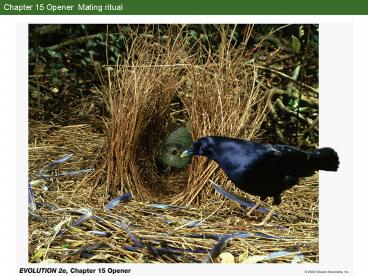Chapter 15 Opener Mating ritual - PowerPoint PPT Presentation
1 / 42
Title:
Chapter 15 Opener Mating ritual
Description:
Chapter 15 Opener Mating ritual – PowerPoint PPT presentation
Number of Views:78
Avg rating:3.0/5.0
Title: Chapter 15 Opener Mating ritual
1
Chapter 15 Opener Mating ritual
2
Figure 15.1 A mutator allele that increases the
mutation rate throughout the genome increased in
frequency and eventually became fixed
3
Figure 15.1 A mutator allele that increases the
mutation rate throughout the genome increased in
frequency and eventually became fixed
4
Figure 15.2 (A) The dandelion Taraxacum
officinale reproduces by apomixis. (B) Rotaria
tardigrada has apparently been parthenogenetic
for a very long time
5
Figure 15.3 Selection against an allele (r) that
promotes recombination
6
Figure 15.3 Selection against an allele (r) that
promotes recombination
7
Figure 15.4 The cost of sex
8
Figure 15.4 The cost of sex
9
Figure 15.5 How linkage disequilibrium affects
the response to selection
10
Figure 15.5 How linkage disequilibrium affects
the response to selection
11
Figure 15.6 Mullers ratchet
12
Figure 15.7 Evidence that selection by a
parasitic trematode may favor sexual reproduction
in a snail with sexual and asexual genotypes
13
Figure 15.8 Effects of recombination on the rate
of evolution
14
Figure 15.9 Evolution of a female-biased sex
ratio in a population structured into local
groups, but periodically forms a single pool of
dispersers
15
Figure 15.9 Evolution of a female-biased sex
ratio in a population structured into local
groups, but periodically forms a single pool of
dispersers
16
Figure 15.10 Adaptive adjustment of individual
sex ratio by a parasitoid wasp in which females
usually mate with males that emerge from the same
host
17
Figure 15.10 Adaptive adjustment of individual
sex ratio by a parasitoid wasp in which females
usually mate with males that emerge from the same
host
18
Figure 15.11 The theory of sex allocation
19
Figure 15.12 The mean number of flowers produced
by Eichhornia paniculata plants from two
populations
20
Figure 15.13 Among elephant seals, a few
dominant males defend harems of females against
other males
21
Figure 15.13 Among elephant seals, a few
dominant males defend harems of females against
other males
22
Figure 15.14 Sex role reversal
23
Figure 15.15 Hornlike structures have evolved
independently in the males of diverse animals
24
Figure 15.16 An elaborate mechanism for
improving a males likelihood of paternity
25
Figure 15.17 The forewing of (A) normal and (B)
silent male crickets, Teleogryllus oceanicus
26
Figure 15.18 Males that provide direct benefits
to females
27
Figure 15.19 A model of runaway sexual selection
by female choice
28
Figure 15.19 A model of runaway sexual selection
by female choice (Part 1)
29
Figure 15.19 A model of runaway sexual selection
by female choice (Part 2)
30
Figure 15.20 Benefits and costs in sexual
selection
31
Figure 15.20 Benefits and costs in sexual
selection
32
Figure 15.21 Evidence for Fishers sexy son
hypothesis
33
Figure 15.21 Evidence for Fishers sexy son
hypothesis
34
Figure 15.22 Evidence supporting sexual
selection as a result of sensory bias in female
mate choice
35
Figure 15.23 Experimental evidence of genetic
conflict between the sexes
36
Figure 15.23 Experimental evidence of genetic
conflict between the sexes
37
Figure 15.24 Among water striders which live on
the surface of water, males forcibly copulate
with females
38
Figure 15.25 A possible example of chase-away
sexual selection
39
Figure 15.26 A model for the evolution of sex
change in sequential hermaphrodites
40
Figure 15.27 (A) Two pathways by which
terminal-phase males develop in the bluehead
wrasse. (B) A terminal-phase male bluehead wrasse
41
Figure 15.27 (A) Two pathways by which
terminal-phase males develop in the bluehead
wrasse. (B) A terminal-phase male bluehead wrasse
42
(No Transcript)































